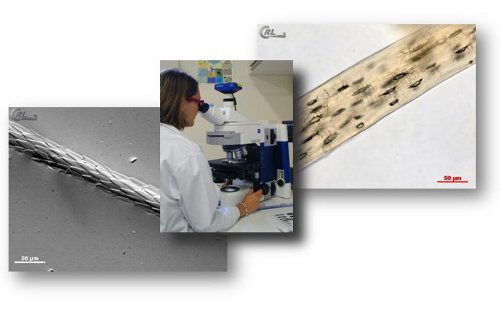European regulation EC/152/2009 (consolidated) and its associated SOPs state that official controls for the detection of PAPs in feed occur by light microscopy, except for aquafeed where only PCR may be used under defined conditions. The microscopic method is based on the identification of animal particles which can be detected by using both a stereomicroscope and a compound microscope. Typical structures such as bone spicules, cartilage fragments, muscle fibres, fish bones and scales, feather’s barbules or hairs can be detected by an experienced operator within plant and mineral matrices used for feeds.
Primarily before performing observations, feed samples are submitted to different treatments:
- Sieving or grinding in order to get particles of appropriate size
- Sedimentation in tetrachloroethylene (TCE) in order to separate the light components from the heavy ones. In general it allows separating most of plant material and other organic material from mineral ones – including animal bones.
- Different optional stainings intended to improve detection of certain constituents (e.g. Alizarin red colouring for bony material)
- Slide mounting with a suitable embedding medium.
Analyses have to be performed on raw sample material or flotate and sedimented material.

The method is qualitative, it means it delivers a result expressed as “present”, “absent” or “<LOD”. Based on morphological and histological features, the method enables to identify animal components from fish origin and “terrestrial” origin. The term terrestrial embraces mammalian and bird animal remains which often present overlapping morphological criteria making them hardly distinguishable from each other. Nevertheless analysis from raw sample material will permit to detect, if present, feather fragments relevant for the presence bird material.
Advantages
The light microscopic method presents several major benefits.
- Low levels of contamination are detectable (<0.1%)
- Good sensitivity and specificity
- Almost universal basic lab equipment
- Inexpensive (few reagents, limited investment)
- Qualitative disclosure of contamination (it allows to differentiate prohibited material such as MBM vs authorised
- Easiness of implementation
- Rapid method
- Well documented field of science (books, manuals, image galleries, etc)
Disadvantages
- Needs experienced microscopists
- Continuous training to keep skills at the top but also because of the emergence of new feed compounds and animal by-products
- No species identification: e.g. the method is unable determine if terrestrial bones originate from bovines, porks, goats…
- Based on particle detection only, some contaminants are not always visible because of manufacturing processes
- No quantification possible